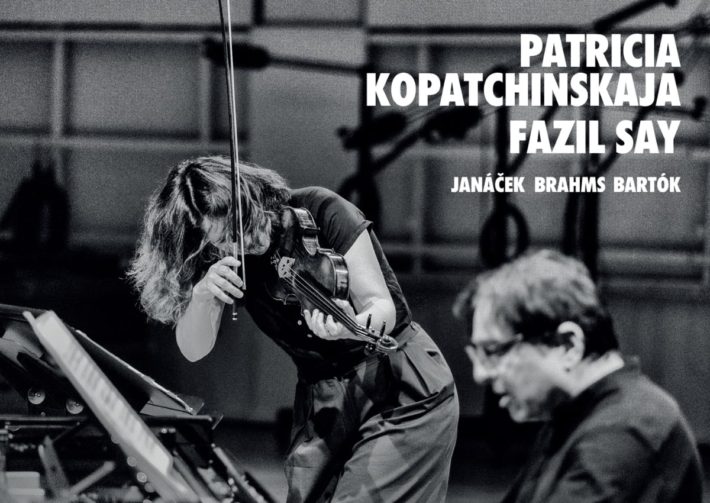This is Patricia Kopatchinskaja’s third collaboration with pianist Fazil Say. Since 2004, the duo has played many concerts together, and the three sonatas on this album certainly confirm their unified artistic vision. That Kopatchinskaja and Say have all the requisite skills for technically immaculate performances is a given, but we should also acknowledge their reputation for unconventional interpretations, a quality most readily apparent in the Brahms sonata.
The program opens with a compelling reading of Janáček’s Violin Sonata. The work feels spontaneously created, in part because these performers shape it with such improvisatory freedom. By comparison the performance by Vadim Repin and Nikolai Lugansky (DG) is more rhythmically strict, their interpretation seemingly focused on a ‘larger than life’ tonal richness. Repin’s unfailingly beautiful playing also softens many of Janáček’s more awkward melodic inflections. Kopatchinskaja speaks Janáček’s distinctive musical language with greater fluency and establishes (with Say) a more intimate atmosphere in the second movement that is deeply touching. After a suitably rambunctious third movement, the sense of struggle in the final Adagio is superbly caught, the violin constantly undermining the piano’s efforts to become fully lyrical.
The performance of Brahms’ third violin sonata is more controversial. Kopatchinskaja and Say employ a similar level of improvisational freedom that, especially in the outer movements, often obscures our sense of the music’s structure. Dynamic contrasts are heightened (or overdone) throughout, and Kopatchinskaja utilizes a variety of articulations, bow weight and tonal color – she is not afraid to let her tone coarsen, or to use a minimal amount of vibrato. Listeners who enjoy the tonal richness of Arabella Steinbacher (Pentatone) or the elegant restraint of Leonidas Kavakos (Decca) or Alina Ibragimova (Hyperion) may well find Kopatchinskaja’s approach overwrought and interventionist. The accompanists, Yuja Wang (Kavakos) and Cédric Tiberghien (Ibragimova) offer accompaniments of similar moderation, whereas Say ensures the piano is an equal and effusive partner. The final two fast movements have plenty of technical elan, the muscular playing excitable and passionate, heightening the music’s Hungarian flavor. In short, this interpretation features stark contrasts of tone and dynamics, with imaginative (some might argue flashy) bow technique. Listeners, especially those who know the work, are likely to find certain passages revelatory, followed by others that exasperate. Tetzlaff, accompanied by the late Lars Vogt, offers a similar approach that is nevertheless not as extreme.
Related Posts
- Review: Beethoven, Schumann, Franck – Violin Sonatas – Capuçon, Argerich
- Review: Bach – Goldberg Variations – Fazil Say, Piano
- Review: “Bohemian Tales” – Augustin Hadelich, Violin
Bartók’s first violin sonata inhabits a much more acerbic sound world and is arguably not audience friendly music. Its rigorous and dissonant writing, with sharply contrasted extremes of register, volume, and texture, plays to the strengths of these performers. Kopatchinskaja plays with ferocious passion, at ease with even the most difficult technical passages. There is never a moment of caution or hesitation which is exactly what this music needs to really speak. I turned to James Ehnes’ 2012 recording (Chandos) for comparison: he too is technically immaculate, with flawless intonation. But the questing, abrasive spirit of the music is only fitfully present. Again, Kopatchinskaja and Say offer a performance that embraces the music’s Hungarian roots. I would turn to Ehnes to admire how the music is put together and the composer’s sheer compositional brilliance. But in this new performance I am drawn into the spirit and emotion of the music.
I urge all potential buyers to avoid reading the liner notes until after you listened to the recording. There is little discussion of the composers and their music. Instead, we are treated to a discussion between the two artists, who excessively fawn over one another. Having listened to the recording first, I felt that the musical works were their priority, despite some challenging interpretational ideas. After reading the liner notes one might think the performances are more about the artists than the music.
The recording offers an excellent balance between piano and violin, captured with clarity and warmth. The Janáček and Bartók are uniformly impressive, but the Brahms will likely divide opinion.

Janáček, Brahms, Bartòk – Violin Sonatas
Patricia Kopatchinskaja – Violin
Fazil Say – Piano
Alpha, ALPHA885
Recommended Comparisons
Read more classical music reviews or visit The Classic Review Amazon store
Follow Us and Comment:
Get our periodic classical music newsletter with our recent reviews, news and beginners guides.
We respect your privacy.









